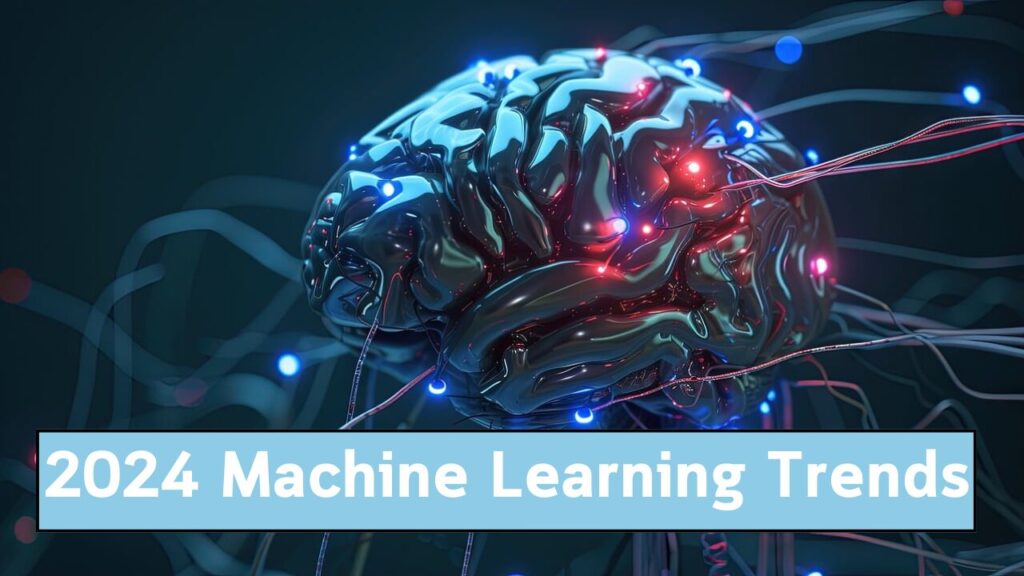2024 Machine Learning Trends: As the landscape of artificial intelligence (AI) rapidly evolves, staying abreast of the latest machine learning trends becomes crucial for professionals and enthusiasts alike. In the coming year, 2024, these trends are set to redefine the boundaries of technology, promising advancements that could reshape industries, enhance decision-making processes, and unlock new realms of innovation. The significance of keeping pace with these developments cannot be overstated, as they hold the potential to catalyze significant breakthroughs in deep learning, large language models, and the compute trends across three eras of machine learning, setting a new benchmark for what is technologically feasible.
This article delves into the core areas defining the future of machine learning, including the continuation of traditional machine learning trends, the explosive growth of generative AI trends, and the emergence of innovative techniques in ML that promise to elevate the field to new heights. Additionally, it explores the widespread impact of ML on different industries, providing a panoramic view of its potential to revolutionize the way we live and work. By shedding light on these pivotal topics, the article aims to equip readers with a comprehensive understanding of the key developments in machine learning and deep learning trends, guiding them through the transformative journey that lies ahead in the dynamic world of artificial intelligence.
Traditional Machine Learning Trends
Hardware Acceleration
The acceleration of machine learning hardware is a pivotal trend that continues to drive the capabilities of traditional machine learning systems. With the doubling of FLOP/s performance approximately every 2.3 years in 47 ML hardware accelerators, the field sees significant advancements in computational abilities 1. Innovations such as switching from FP32 to tensor-FP16 have resulted in a performance increase by nearly tenfold, showcasing the rapid evolution of processing power 1.
Moreover, proprietary chip-to-chip interconnect protocols like Nvidia’s NVLink or Google’s TPU’s ICI are enhancing communication bandwidth, with NVLink in H100 supporting seven times the bandwidth of PCIe 5.0 1. These improvements are crucial for the development of more sophisticated and efficient machine learning models, particularly in environments demanding high computational throughput.
Machine Learning Operations (ML Ops)
Machine Learning Operations, or MLOps, integrates key practices from DevOps with machine learning, focusing on the lifecycle management of ML models in production environments. The adoption of MLOps is becoming increasingly essential as it facilitates enhanced collaboration among data scientists, ML engineers, and DevOps teams, ensuring that ML models are not only scalable and reliable but also maintainable over time 2.
A notable shift in MLOps is the growing emphasis on automation and monitoring. Tools that automate the deployment and monitoring of machine learning models are becoming more sophisticated, helping to streamline operations and reduce the manual burden on teams 3. This automation extends to model retraining and updating, ensuring models remain effective as new data becomes available 4.
Additionally, the integration of advanced MLOps platforms supports a wide range of capabilities, from data management and preprocessing to model deployment and real-time performance tracking 5. These platforms not only simplify the ML workflow but also promote standardization and best practices across projects, significantly enhancing the overall efficiency and effectiveness of machine learning initiatives 2 5.
By embracing these trends in hardware acceleration and MLOps, organizations can better harness the power of traditional machine learning to drive innovation and maintain a competitive edge in an increasingly data-driven world.
Generative AI Trends
In 2024, the landscape of generative AI continues to evolve with significant advancements in both text and image generation. These developments are not only enhancing the capabilities of AI but also expanding its applications across various sectors.
2024 Machine Learning Trends: Text Generation
The use of AI in text generation has become increasingly sophisticated, with tools like ChatGPT leading the forefront since its launch in November 2022. The adoption of these AI chat tools is expected to rise as more companies develop their own AI-powered applications to make internal information more accessible and reduce operational costs 4. Notably, businesses are integrating generative AI chatbots by fine-tuning models such as Llama 2 or using pre-trained models like GPT-4, connected to vector databases that store company documents 4.
Moreover, the text generation market has seen a variety of applications, from content creation for blogs and advertising to developing code snippets and virtual assistants. Tools like Jasper and Copy.ai have been particularly noted for their ability to produce high-quality, engaging content that effectively turns readers into clients 6 7.
Image Generation
The field of AI-driven image generation has also witnessed remarkable growth, particularly with the introduction of models like DALL-E 2, Midjourney, and Stable Diffusion in 2022. These models have continued to receive updates, improving their capabilities and expanding into new areas such as AI-generated GIFs and short clips 4. Despite the niche applications, the impact of these tools is significant, providing users with powerful resources to generate creative and detailed visual content.
Current trends indicate a move towards more multimodal applications, where AI can handle text, images, and even audio inputs to produce comprehensive multimedia content. This shift is evident with tools like OpenAI’s GPT-4, which now supports multimodal interactions, allowing for a more integrated and versatile user experience 8 9.
As generative AI continues to mature, the expectations for these technologies to seamlessly integrate multiple forms of media are increasing, pointing towards a future where AI can more closely mimic human creativity and versatility 8 9.
Innovative Techniques in ML
The field of machine learning is continually advancing with new methodologies that enhance the capabilities of models to interpret and interact with data. Two such emerging techniques are Zero-shot Classification and Infinite Context Transformers, which are setting new benchmarks in the realm of artificial intelligence.
Zero-shot Classification
Zero-shot Classification (ZSC) is a revolutionary approach where models can accurately identify instances they have never explicitly seen during training. This method leverages semantic representations and transfer learning to classify new objects by understanding the underlying relationships and attributes that define different classes 10. For instance, ZSC enables models to categorize images into unseen categories by using multi-modal models that align visual and textual information, thus offering significant flexibility and scalability across various domains 11.
The ZLaP technique, an enhancement for Vision Language Models, exemplifies the application of ZSC by using geodesic distances within a graph-structured dataset for improved classification accuracy 12. This method not only handles dual modalities of text and images but also shows superior performance across multiple datasets, making it a promising development in zero-shot learning 12.
Infinite Context Transformers
Infinite Context Transformers introduce a novel approach to processing extremely long inputs without the constraints of traditional models. The Infini-attention mechanism, a core component of this technique, incorporates a compressive memory system into the attention framework, allowing for the efficient handling of long-term and local information within a transformer network 13. This mechanism supports continual pre-training and long-context adaptation, enabling models to perform tasks that involve detailed contextual understanding, such as book summarization or passkey retrieval from extensive sequences 13.
These innovative techniques in machine learning are not only enhancing the theoretical capabilities of models but are also paving the way for practical applications that were previously unfeasible. As these methodologies evolve, they continue to push the boundaries of what artificial intelligence can achieve, promising more sophisticated and versatile AI tools in the future.
Impact of ML on Different Industries
Healthcare
Machine learning (ML) and artificial intelligence (AI) are revolutionizing the healthcare industry by enhancing operational efficiency and improving patient care. Notably, AI and ML are integral in developing more precise and individualized diagnoses and treatment plans by evaluating vast volumes of patient data. For example, AI-driven diagnostics achieve a sensitivity of 87.0% and specificity of 92.5%, comparable to human experts in medical imaging 14. Furthermore, AI solutions in healthcare are pivotal in disease prevention, monitoring potential outbreaks, and even predicting them to prevent pandemics 14.
Finance
In the finance sector, AI has become a transformative force, driving innovations that enhance efficiency, manage risks, and improve customer experiences. AI-driven tools like chatbots provide 24/7 customer support using natural language processing to understand and respond to inquiries 15. Additionally, AI plays a crucial role in risk management by providing more accurate assessments and predictive analytics, allowing financial institutions to model various risk scenarios effectively 15. The integration of AI with blockchain technology is creating new opportunities by enhancing data processing and decision-making, while ensuring secure, transparent data storage 15.
Retail
The retail industry is leveraging ML to gain a competitive edge by optimizing pricing strategies, managing supply chains, and enhancing customer experience. Machine learning algorithms are used for demand forecasting, fraud detection, and customer behavior analysis, among other tasks 16. Despite some skepticism, the benefits include targeted marketing campaigns and increased customer satisfaction 16. Moreover, AI supports real-time inventory management and predictive analytics, enabling retailers to anticipate and react to changes swiftly, thereby reducing errors and enhancing customer service 17.
Conclusion
2024 Machine Learning Trends: Throughout the exploration of 2024’s machine learning trends, we’ve traversed the spectrum from traditional machine learning advancements and MLOps to the dynamic realms of generative AI and innovative ML techniques. These pivotal areas underscore the monumental shifts occurring within the AI landscape, heralding a future where the integration of AI across various sectors like healthcare, finance, and retail, not only augments operational efficiencies but also pioneers novel approaches to problem-solving and innovation. The insights into hardware acceleration, text and image generation, along with the breakthrough methodologies in zero-shot classification and infinite context transformers, collectively exemplify the robust trajectory of AI’s evolution, setting a foundation for revolutionary applications and models that promise to transcend today’s technological limitations.
Reflecting on the implications of these trends, it becomes evident that the journey ahead in the AI domain is ripe with opportunities for profound impact and transformative change. The confluence of advanced techniques and their applicability across diverse industries signifies a pivotal moment for stakeholders to harness the power of AI, urging a continual pursuit of knowledge and adaptation to these rapidly evolving technologies. As we stand on the cusp of these developments, the call for further research and collaborative innovation is clear, inviting a future where the bounds of what’s possible are continually expanded through the lens of machine learning.
FAQs: 2024 Machine Learning Trends
What are the expected trends in machine learning for the year 2024?
In 2024, artificial intelligence (AI) and machine learning (ML) are set to further integrate into everyday life through applications in autonomous vehicles and smart homes. Additionally, advancements in natural language processing (NLP) are anticipated to enhance how technology interacts with human language.
What does the future hold for machine learning advancements?
The future of machine learning is gearing towards the development of large, versatile models capable of performing multiple tasks simultaneously. This innovation will simplify the user’s need to understand specific applications of a framework, as these models will be more universally applicable.
What are the innovations in AI expected by 2024?
By 2024, AI is expected to evolve into multimodal systems that can process and understand various types of data, including audio, video, images, and text. This advancement will make search engines and content creation tools more intuitive and better integrated with other commonly used applications.
Will machine learning offer promising career opportunities in 2025?
Yes, machine learning is projected to be a lucrative career field in 2025. Machine learning engineers, who collaborate extensively with software engineers and data scientists, are crucial in developing sophisticated algorithms and systems. This role is considered one of the top AI jobs with high earning potential.





